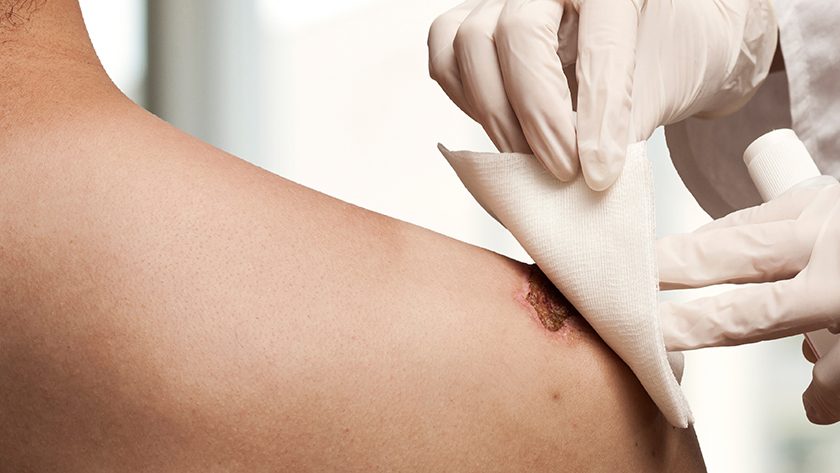The United States accounts for over 6 million people living with chronic wounds. Peripheral arterial disease is a common cause of chronic wounds, especially in the aging patient population in the country. Moreover, 8 - 10% of all lower extremity wounds are arterial. Hence, a better understanding of arterial ulcers can allow wound care professionals to accurately differentiate the disease from other ulcers and provide adequate wound care for patients with it.
What are Arterial Wounds?
Arterial wounds (or ulcers) are skin injuries resulting from poor blood circulation. These wounds generally occur in the lower extremities due to an obstruction of blood flow, causing oxygen deprivation and consequent death of tissues.
Unlike venous wounds that result from damage to the veins, damage to the arteries is the common cause of arterial ulcers. Although the two wound types are similar, each requires peculiar treatment options to ensure adequate and rapid wound healing.
The severe pain associated with arterial wounds intensifies patient discomfort. Poor blood circulation can result in slow wound healing due to inadequate nutrient delivery by red blood cells. Moreover, a lack of white blood cells reduces protection against bacteria and increases the likelihood of infections.
Leaving arterial wounds untreated for a prolonged period can cause other severe health complications, including tissue necrosis, infection, and amputation.
Symptoms of Arterial Wounds
Some signs and symptoms of arterial wounds include:
- Zero bleeding with black, grey, brown, or yellow-colored sores
- Wound site coolness resulting from lack of blood circulation
- Redness of leg when dangled, paleness when propped or elevated
- Round-shaped sores with well-defined margins
- Deep sores
- Sores around outer ankles, heels, toes, or in between the toes
Risk Factors of Arterial Wounds
While blocked or damaged arteries are the major causes of arterial wounds, several other risk factors are associated with the disease. Arterial ulcers occur in middle-aged men and other patients with the following risk factors:
- Diabetes
- Hypertension
- African American ancestry
- Family history
- Dyslipidemia
- Smoking
- High cholesterol
- High blood pressure
- Trauma
Moreover, other etiologies associated with the pathogenesis of arterial wounds include:
- Sickle cell disease
- Atherosclerosis
- Buerger's disease
- Vasculitis
- Peripheral vascular disease
How to Manage Arterial Wounds: Basic Principles
Wound care professionals and podiatrists must identify and address underlying causes and risk factors associated with arterial wounds. These professionals must then ensure patients adhere to the following basic principles:
Increased Physical Activity
Regular exercise and walking can help reduce pains and effectively manage the symptoms of peripheral vascular disease, a common risk factor for arterial wounds. Thus, increasing the chance of the patient at optimal wound healing.
Cessation of Smoking
Since smoking promotes the progression of peripheral vascular disease, arterial wound patients must leverage behavioral changes to improve the wound healing process.
Proper Nutrition
Eating right ensures patients get the proper nutrients necessary to expedite wound healing.
Compression Therapy Avoidance
Since arterial wound patients already suffer from blocked or damaged arteries, which cut blood and oxygen supply to the affected area, professionals must be cautious when opting for compression therapy as it can further block blood flow.
Treatment Options for Arterial Wounds
Localized wound care, utilization of medications, and surgical management are three key treatment options for arterial wounds. These options aim to minimize pains associated with the disease and, ultimately, speed up the healing process.
Localised Wound Care
Localized wound care for arterial wounds includes infection control, wound cleansing, and dressing. Since arterial ulcers are susceptible to bacterial contamination and colonization, professionals can opt for cadexomer iodide and silver dressings for wound infection treatment. Moreover, antibiotic therapy is ideal for deep tissue infections.
Patients also require wound cleaners, such as 0.9% normal saline or water, to eliminate debris and necrotic tissues which impede wound healing. Although commercial cleaners are sometimes toxic to granulation tissues, they are effective for wounds with heavy bacterial burdens.
Wound care professionals can leverage moist, non-adherent dressings for arterial wounds since they secrete minimal exudates and exhibit fragile periwound skin.
Medications
Antiplatelet drugs, cilostazol, statins, and analgesia are some key medications that aid arterial wound healing. Antiplatelet drugs, such as Aspirin and Clopidogrel, prevent platelet aggregation and hinder the progression of peripheral vascular disease.
Moreover, Cilostazol effectively manages peripheral vascular disease and, by extension, arterial wounds. While statins lipid levels in the blood and treats atherosclerosis, a common risk factor of arterial ulcers, analgesia minimizes pains and improves tissue perfusion.
Both medications are ideal for managing arterial wounds and optimal wound healing.
Surgical Management
This option aims to restore blood supply to the affected tissues. Wound care professionals opt for surgical treatment when the wound is unresponsive to localized wound care and medications. Further confirmations using MR angiography or CT angiography are essential for assessing distal vessel patency before any surgical procedure.
Two key surgical options for arterial wound treatment include bypass graft and endovascular procedures. Bypass graft aids the revascularization of lower limbs, resulting in five-year patency of about 70%.
Endovascular procedures, which are less invasive and complicated, are more preferred for arterial wound treatments. The two options are ideal for the treatment of this disease and for minimizing the chances of amputation.
Bottom Line
Arterial wounds account for a significant portion of lower extremity wounds: the disease results from limited blood supply to the limbs due to blocked or damaged arteries. Peripheral vascular disease, atherosclerosis, smoking, high cholesterol, and blood pressure are common risk factors for this disease. Wound care professionals and podiatrists must account for relevant underlying factors when managing arterial wounds. Moreover, these professionals can opt for local wound care, medications, and surgical management to expedite wound healing and avoid amputation.



.webp)

.avif)